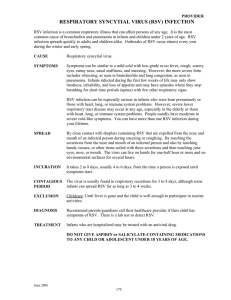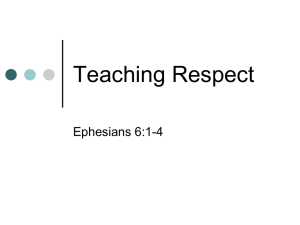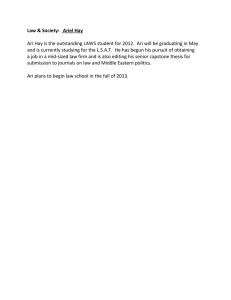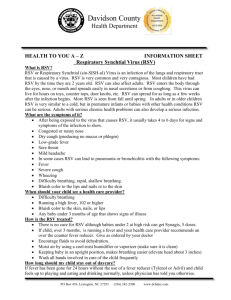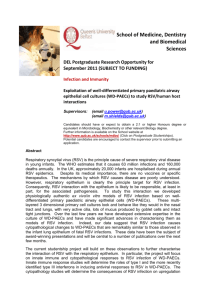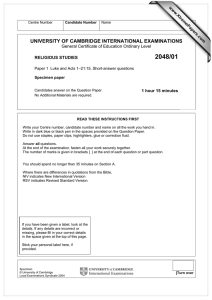Wh i i f ti f
advertisement
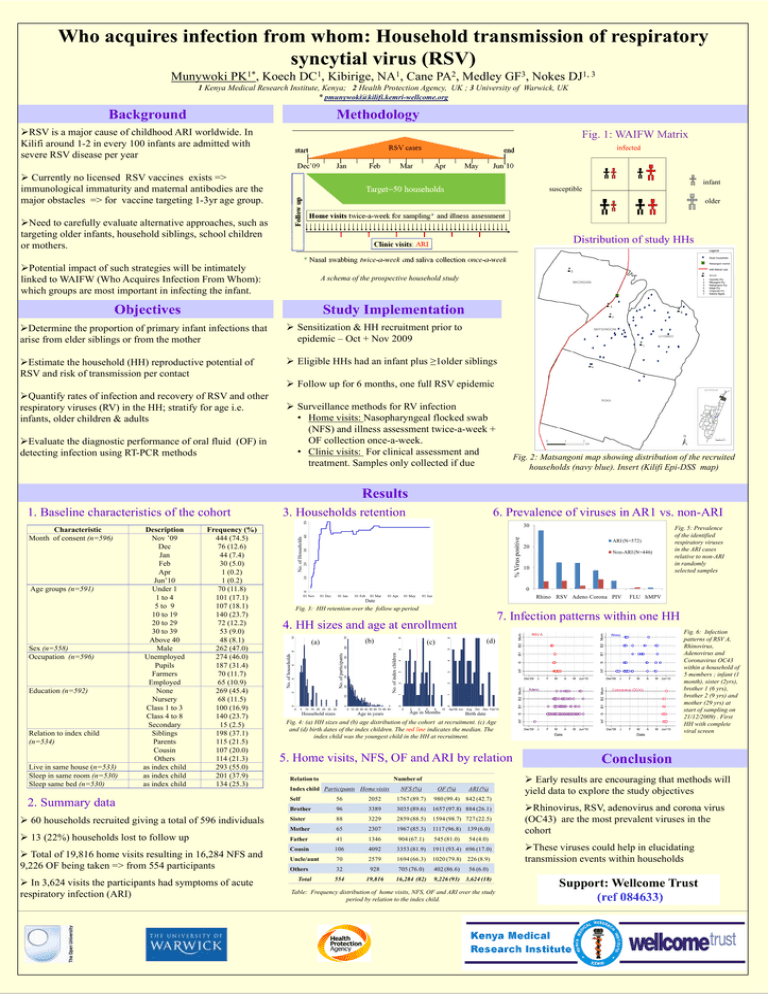
Wh acquires Who i iinfection f ti from f whom: h Household H h ld transmission t i i off respiratory i t syncytial virus (RSV) Munywoki PK1*, Koech DC1, Kibirige, Kibirige NA1, Cane PA2, Medley GF3, Nokes DJ1,, 3 1 Kenya Medical Research Institute, Kenya; 2 Health Protection Agency, UK ; 3 University of Warwick, UK * pmunywoki@kilifi.kemri-wellcome.org Background Methodology ¾RSV is a major cause of childhood ARI worldwide. In Kilifi around 1-2 in every 100 infants are admitted with severe RSV disease di per year Fig. g 1: WAIFW Matrix infected ¾ Currently no licensed RSV vaccines exists => immunological immaturity and maternal antibodies are the major obstacles => > for vaccine targeting 11-3yr 3yr age group group. infant susceptible older ld ¾Need to carefully evaluate alternative approaches, such as targeting older infants, household siblings, school children or mothers. mothers Distribution of study y HHs ¾Potential impact of such strategies will be intimately linked to WAIFW (Who Acquires Infection From Whom): which groups are most important in infecting the infant. infant A schema of the prospective household study Obj ti Objectives St d IImplementation Study l t ti ¾Determine the proportion of primary infant infections that arise i ffrom elder ld siblings ibli or from f the h mother h ¾ Sensitization & HH recruitment prior to epidemic id i – Oct O t+N Nov 2009 ¾Estimate the household ((HH)) reproductive p potential p of RSV and risk of transmission per contact ¾ Eligible HHs had an infant plus ≥1older siblings ¾Quantify rates of infection and recovery of RSV and other respiratory viruses (RV) in the HH; stratify for age i.e. infants, older children & adults ¾Evaluate the diagnostic performance of oral fluid (OF) in detecting infection using RT-PCR methods ¾ Follow F ll up for f 6 months, th one full f ll RSV epidemic id i ¾ Surveillance methods for RV infection • Home visits: Nasopharyngeal flocked swab (NFS) and illness assessment twice twice-a-week a week + OF collection once once-a-week. a week. • Clinic visits: For clinical assessment and treatment. Samples only collected if due Fig 2: Matsangoni map showing distribution of the recruited Fig. households (navy blue). Insert (Kilifi Epi-DSS map) R l Results 3. Households retention 6. Prevalence of viruses in AR1 vs. non-ARI Relation to index child (n=534) Live in same house (n=533) Sleep p in same room ((n=530)) Sleep same bed (n=530) 2. Summary data ¾ 60 households recruited ggivingg a total of 596 individuals ¾ 13 (22%) households lost to follow up ¾ Total of 19,816 19 816 home visits resulting in 16,284 16 284 NFS and 9,226 OF beingg taken => from 554 participants p p ¾ In 3,624 3,6 visits v s ts the t e participants pa t c pa ts had ad symptoms sy pto s of o acute respiratory infection (ARI) % Virus possitive 40 300 20 2 10 0 ARI (N=572) 20 Non-ARI (N=446) 10 01 Jan 01 Feb 01 Mar 01 Apr 01 May Rhi Rhino RSV Adeno Ad C Corona PIV 01 Jun Date Fig. g 3: HH retention over the follow f up p pperiod B1 S Inf Inf M A M Jun'10 Dec'09 J F M A M Jun'10 Apr'09 Jun B2 Mum Aug Oct Dec Feb'10 Birth date A M Jun'10 Number of NFS (%) OF (%) ARI (%) 56 2052 1767 (89.7) 980 (99.4) 842 (42.7) Brother 96 3389 3035 (89.6) (89 6) 1657 (97 (97.8) 8) 884 (26.1) (26 1) Sister 88 3229 2859 (88.5) 1594 (98.7) 727 (22.5) Mother 65 2307 1967 (85.3) 1117 (96.8) 139 (6.0) Father 41 1346 904 (67 (67.1) 1) 545 (81.0) (81 0) 54 (4.0) (4 0) Cousin 106 4092 3353 (81.9) 1911 (93.4) 696 (17.0) Uncle/aunt 70 2579 1694 (66.3) 1020 (79.8) 226 (8.9) Others 32 928 705 (76.0) 402 (86.6) 554 19,816 16,284 (82) B1 10 S 8 Coronavirus (OC43) Inf 6 Adeno B1 4 Self Total F S 2 Age in Months 5. Home visits, NFS, OF and ARI by y relation Index child Participants Home visits Rhino 2 1 0 Fig. 4: (a) HH sizes and (b) age distribution of the cohort at recruitment. (c) Age and (d) birth dates of the index children. The red line indicates the median. The index child was the youngest child in the HH at recruitment. Relation to J Inf Age in years 0 0 0 10 20 30 40 50 60 70 80 90 100 B2 Mum B1 4 3 S 4 3 1 10 10 15 20 25 30 35 40 Household sizes Dec'09 2 No. of index childreen 50 0 40 30 20 2 No. of paarticipannts N 8 6 4 5 RSV A 5 (c) 5 60 (d) 6 (b) 6 70 10 4 HH sizes and age at enrollment 4. (a) FLU hMPV 7. Infection patterns within one HH B2 Mum 01 Dec B2 Mum 01 Nov 0 Fig. 5: Prevalence of the identified respiratory viruses in the ARI cases relative to non-ARI in randomly selected samples 0 0 Education (n=592) 30 No. of hoousehold N ds Sex (n=558) Occupation (n=596) Frequency (%) 444 (74.5) 76 (12.6) ( ) 44 (7.4) 30 (5.0) 1 (0.2) 1 (0.2) (0 2) 70 (11.8) 101 (17.1) (17 1) 107 (18.1) 140 (23.7) 72 (12.2) ( ) 53 (9.0) 48 (8.1) 262 (47.0) 274 (46.0) (46 0) 187 (31.4) 70 (11.7) (11 7) 65 (10.9) 269 (45.4) 68 (11.5) ( ) 100 (16.9) 140 (23.7) (23 7) 15 (2.5) 198 (37.1) (37 1) 115 (21.5) 107 (20.0) (20 0) 114 (21.3) 293 (55.0) 201 ((37.9)) 134 (25.3) 2 Age groups (n=591) Description Nov ’09 Dec Jan Feb Apr Jun’10 Jun 10 Under 1 1 to t 4 5 to 9 10 to 19 20 to 29 30 to 39 Above 40 Male Unemployed Pupils F Farmers Employed None Nurseryy Class 1 to 3 Class 4 to 8 Secondary Siblings Parents C i Cousin Others as index child as index child as index child 0 Characteristic Month of consent (n=596) No. of Housseholds 50 1. Baseline characteristics of the cohort Dec'09 J F M A Date M Jun'10 Dec'09 J F M Date Fig. 6: Infection ppatterns off RSV A,, Rhinovirus, Adenovirus and Coronavirus OC43 within a household of 5 members ; infant (1 month), sister (2yrs), b th 1 (6 yrs), brother ) brother 2 (9 yrs) and mother (29 yrs) at start of sampling on 21/12/2009) . First HH with complete viral screen Conclusion ¾ Early results are encouraging that methods will yyield data to explore p the studyy objectives j ¾Rhinovirus, RSV ¾Rhinovirus RSV, adenovirus and corona virus (OC43) are the most prevalent viruses in the cohort ¾These viruses could help in elucidating transmission events within households 56 (6.0) 9,226 (93) 3,624 (18) Table: Frequency distribution of home visits, NFS, OF and ARI over the study period by relation to the index child. Support: Wellcome Trust 084633) ((ref e 08 633)

